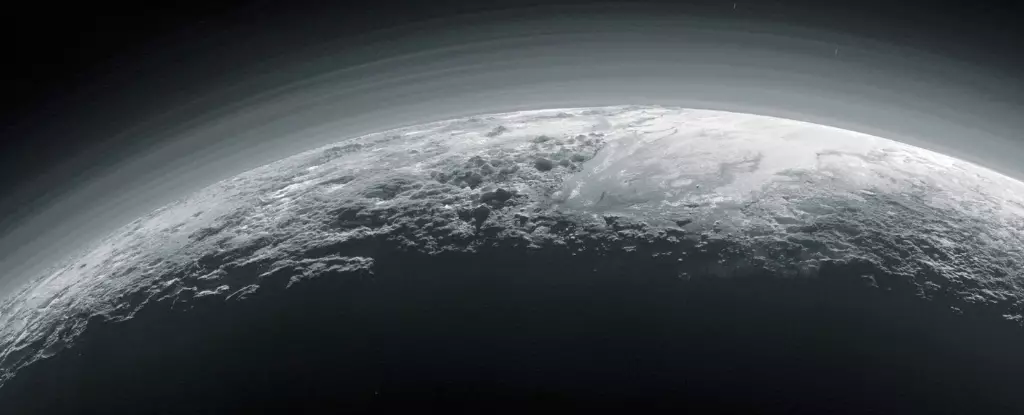In 2015, the momentous flyby of Pluto by the New Horizons spacecraft marked a significant breakthrough in planetary science. It not only offered humanity the first close-up images of Khepri, the distant dwarf planet, but also unveiled an astonishingly complex atmosphere previously shrouded in mystery. What was presumed to be an inhospitable icy body turned out to be an intricate tapestry of nitrogen, methane, and carbon monoxide, gaining confusing dynamics and environmental behaviors. As captivating as this may have been, the journey of discovery did not end with those initial snapshots. Recent insights derived from the James Webb Space Telescope (JWST) observations in 2022 and 2023 have taken our understanding of Pluto’s atmosphere to a deeper mental frontier.
The Intricate Dance of Haze Particles
What sets Pluto apart from its planetary neighbors is not merely its remote location — it’s the behavior of its atmosphere and the peculiar haze enveloping it. New data from the JWST reveal that Pluto’s atmosphere is distinctively contrasted from any observed in our Solar System, primarily because of the dynamic haze particles. This haze, a mixture of nitrogen and methane, plays a critical role in regulating thermal balance, exhibiting a unique ability to rise and fall in response to temperature shifts. This intricate process has sparked considerable interest among astronomers, hinting at an atmospheric control technique that seems to diffuse away from conventional norms established through studies of other celestial bodies.
The insights from the JWST were driven by a hypothesis presented by astronomer Xi Zhang in 2017, which at first glance seemed like an eccentric notion. Nevertheless, the scientific community’s eagerness to explore this “crazy idea” led to an exuberant revelation: the haze particles are not just a surrounding accent; they dictate the thermal equilibrium of the planet’s atmosphere. This critical confirmation reflects the rapid pace at which empirical science can evolve, especially in planetary science contexts where observation opportunities can be sparse.
Illuminating the Mysteries of Charon
In stark contrast, Pluto’s largest moon, Charon, operates under a different atmospheric regime. Largely void of a significant atmosphere, Charon might only exhibit sporadic outgassing influenced by seasonal variations. The initiation of this comparative study between Pluto and Charon is paramount, as understanding the atmospheric functions on both bodies can lead to a deeper appreciation of their interactions. While Pluto showcases an active experimentation with its nitrogen and methane photochemistry, Charon serves as a compelling juxtaposition, delineating the transition between atmospheric richness and scarcity.
To unravel these dynamics further, the latest JWST observations, focusing on the mid-infrared spectrum, have unveiled intriguing variations in thermal radiation as both Pluto and Charon rotate. This newfound data takes into account crucial parameters such as thermal inertia and emissivity, providing a clearer narrative to the continuous shifts of ice on Pluto’s surface. The interplay between these elements drives ice migration, exhibiting a curious phenomenon where material transitions from Pluto to Charon — an occurrence yet to be witnessed in other Solar System bodies.
The Bigger Picture: Cosmic Insights
Why should these revelations matter? Beyond their scientific novelty, understanding Pluto and its atmospheric peculiarities grants us reflective insights into Earth’s own early environment. Some researchers postulate that Pluto’s haze and chemical compositions could afford clues about the conditions that facilitated early Earth’s habitability. This intriguing parallel ignites the imagination; perhaps the key to understanding the early biosphere lies folded within the familiar structures of a distant world marked by frigid temperatures and hazy compounds.
Pluto stands as an extraordinary case study — a planet that operates at the edges of our current knowledge, where atmospheric behavior deviates from earthly norms. It not only encourages a rethinking of atmospheric theories but also opens doors to explorative discussions around other regions, such as Triton and Titan, which possess striking similarities in terms of atmospheric chemistry.
Looking to the Future
While humanity has achieved unprecedented access to distant worlds through instruments like the JWST, these findings are but initial revelations in a further-reaching inquiry. With Pluto influencing our understanding of atmospheric behavior in extreme contexts, it signifies the potential for future explorations that might continue to unlock secrets buried in the cosmos. Piquing curiosity, these discoveries challenge scientists and astronomers alike to navigate through the uncharted waters of planetary atmospheres – a pursuit ignited by the mystery behind Pluto’s unexpected vibrancy.


Leave a Reply